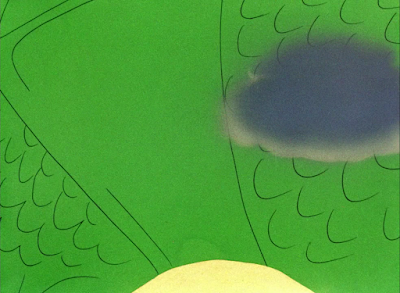The last cartoon was Dino’s Serenade (copyright 1958). The story is by a young John Urie. I don’t want to bash his work because he contributed much to computer animation in the ‘60s and gave work to many young people when he formed his own company. But this short doesn’t seem to do much more than fill time.
Hamilton Ham isn’t even in the cartoon. Dino is an Italian violin player who frolics around while a background singer (actor Hal Peary, in dialect) raptures about any day being a good day for him to make love.
Being a UPA cartoon, cuts and wipes are just too, too pedestrian. We get backgrounds dissolving, eventually becoming a solid pink card.





Dino’s violin case is full of stuff. He pulls out sections of an Italian restaurant and sets them up. Out of nowhere, a waiter comes outside from the restaurant and sets up tables, brings out a bottle of red wine (Dino approves), and pours two glasses (then returns for Dino to give him a tip). The waltz-tempo song about starting “love’s conflagration at any sidewalk café” continues in the background.

Now the cartoon gets creepy. Dino pulls out an immobile female from his violin case and plays for her. Is a blow-up sex doll? Is it a real woman who is asleep?

There’s something else in the violin case—a villain who resembles Reggie Van Gleason. He even does the Gleason “exit” shoulder hunch. What’s he doing in there? Anyway, the villain runs off the now-awakened woman while Dino is completely engrossed in his violin playing.


The waiter takes down the pieces of the front of the restaurant and drop them into the violin case.
What happens now? A dissolve back to the beginning and Dino merrily dances away, as if nothing has happened.
 After watching this cartoon, I think he’s right. Nothing has happened.
After watching this cartoon, I think he’s right. Nothing has happened.
Jimmy Murakami is responsible for the designs, while Fred Crippen gets the direction credit. There are no animation credits so whether Crippen animated this himself, I don’t know.
The internet says the cartoon was released to theatres on January 16, 1959 but to the right you see an ad from December 27, 1958 which shows the cartoon was appearing in one theatre in Wausau, Wisconsin then.
To be honest, if I want Dino, I’ll either take the Flintstones’ dinosaur (animated by George Nicholas) or the “Everybody Loves Somebody Sometime” King of Cool.









































